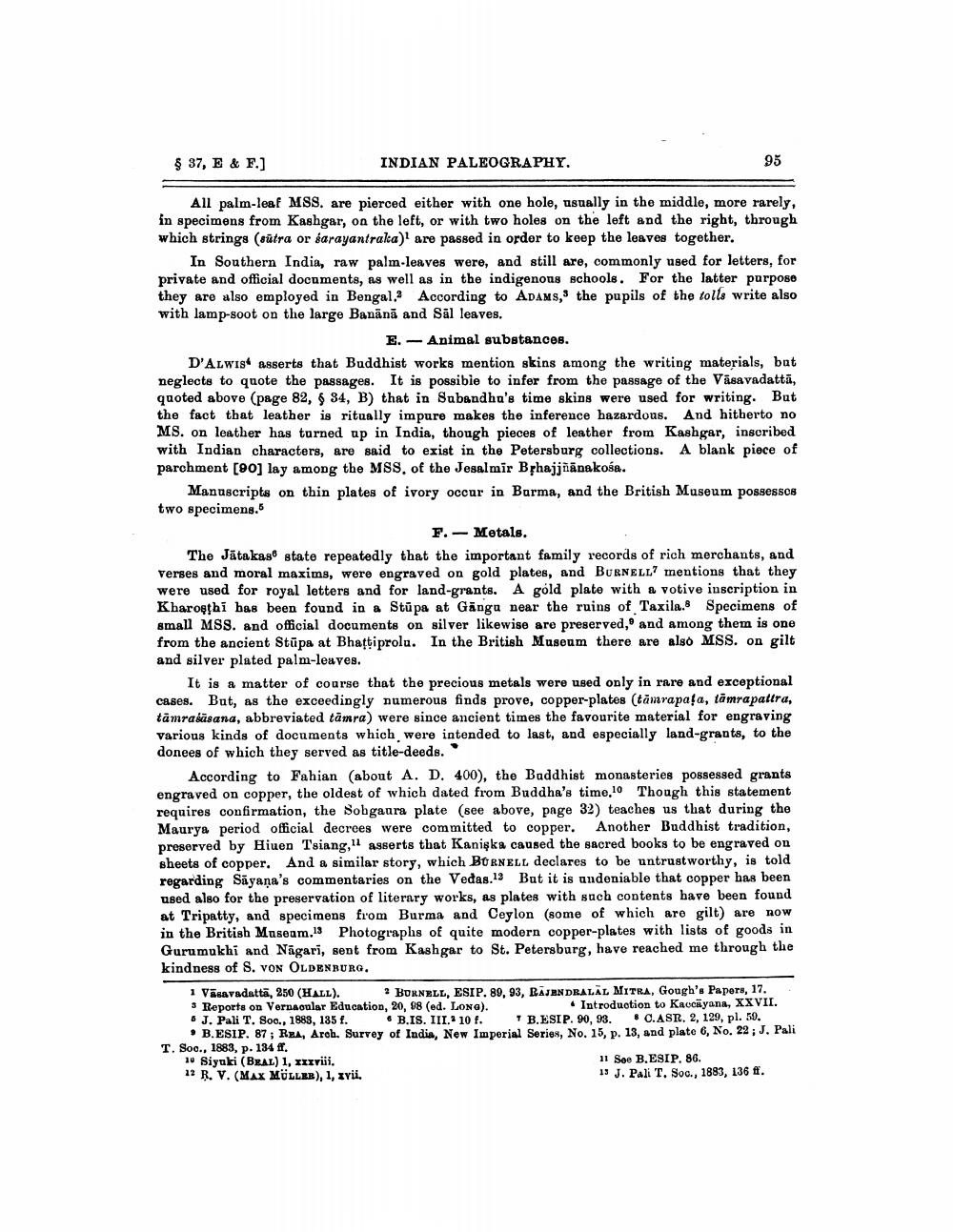________________
$ 37, E & F.]
INDIAN PALEOGRAPHY.
95
All palm-leaf MSS. are pierced either with one hole, usually in the middle, more rarely, in specimens from Kashgar, on the left, or with two holes on the left and the right, through which strings (sūtra or sarayantraka) are passed in order to keep the leaves together.
In Southern India, raw palm-leaves were, and still are, commonly used for letters, for private and official documents, as well as in the indigenous schools. For the latter purpose they are also employed in Bengal. According to Adams, the pupils of the tolls write also with lamp-soot on the large Banānā and Sal leaves.
E. - Animal substances. D'Alwis asserts that Buddhist works mention skins among the writing materials, bat neglects to quote the passages. It is possible to infer from the passage of the Vasavadattā, quoted above (page 82, 34, B) that in Subandha's time skins were used for writing. But the fact that leather is ritually impure makes the inference hazardous. And hitherto no MS. on leather has turned up in India, though pieces of leather from Kashgar, inscribed with Indian characters, are said to exist in the Petersburg collections. A blank piece of parchment [90] lay among the MSS. of the Jesalmir Bhajjnanakosa.
Manuscripts on thin plates of ivory occur in Burma, and the British Museum possessos two specimens.5
F. - Metals. The Jätakaso state repeatedly that the important family records of rich merchants, and verses and moral maxims, were engraved on gold plates, and BURNELL? mentions that they were used for royal letters and for land-grants. A gold plate with a votive inscription in Kharopthi has been found in a Stupa at Gänga near the ruins of Taxila. Specimens of small MSS. and official documents on silver likewise are preserved, and among them is one from the ancient Stüpa at Bhattiprolu. In the British Museum there are also MSS. on gilt and silver plated palm-leaves.
It is a matter of course that the precious metals were used only in rare and exceptional cases. But, as the exceedingly numerous finds prove, copper-plates (tāmrapala, tamrapatira, tämrasāsana, abbreviated tamra) were since ancient times the favourite material for engraving various kinds of documents which were intended to last, and especially land-grants, to the donees of which they served as title-deeds.
According to Fahian (about A. D. 400), the Baddhist monasteries possessed grants engraved on copper, the oldest of which dated from Buddha's time. Though this statement requires confirmation, the Sobgaura plate (see above, page 32) teaches us that during the Maurya period official decrees were committed to copper. Another Buddhist tradition, preserved by Hiuen Tsiang," asserts that Kanişka caused the sacred books to be engraved on sheets of copper, And a similar story, which BURNELL declares to be untrustworthy, is told regarding Sāyaṇa's commentaries on the Vedas. But it is undeniable that copper has been used also for the preservation of literary works, as plates with such contents have been found at Tripatty, and specimens from Burma and Ceylon (some of which are gilt) are now in the British Museam.13 Photographs of quite modern copper-plates with lists of goods in Gurumukhi and Nagari, sent from Kashgar to St. Petersburg, have reached me through the kindness of S. von OLDENBURG.
1 Vasavadatta, 250 (HALL). BURNELL, ESIP. 89, 93, RAJANDRALAL MITRA, Gough's Papers, 17. 3 Reports on Vernacular Education, 20, 98 (ed. LONO).
• Introduction to Kaucāyana, XXVII. • J. Pali T. Soo., 1883, 185 f. B.IS. III. 10 f. "BESIP. 90, 93. C.ASR. 2, 129, pl. 50.
• B.ESIP. 87; RXA, Aroh. Survey of India, New Imperial Series, No. 15, p. 13, and plate 6, No. 22;J. Pali T. Soc., 1883, p. 134 ff. 10 Siyuki (BRAL) 1, Xxxviii.
11 See B.ESIP. 86. 12 R. V. (Max MÖLLEB), 1, xvii.
13 J. Pali T. Soc., 1883, 136 ff.




